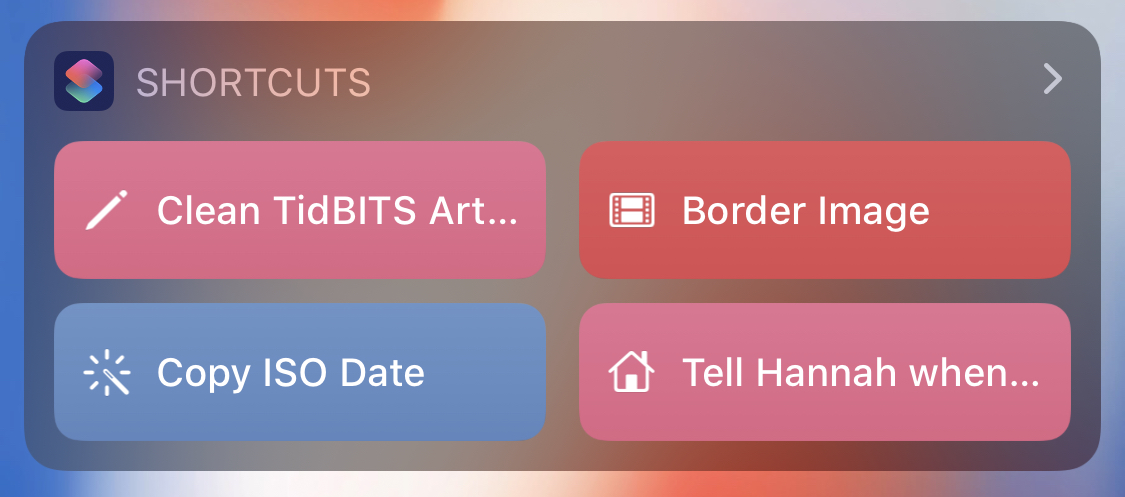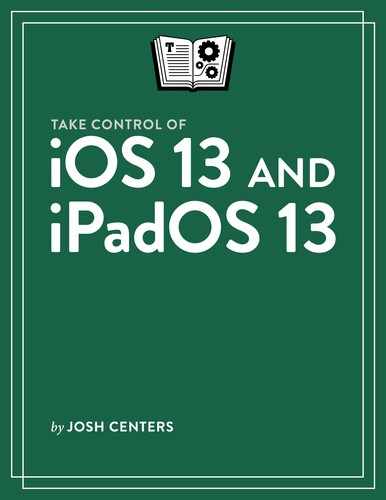Take a Shortcut
Apple’s Shortcuts app will let you automate common actions in iOS, such as sending messages to friends, calculating tips, and sharing photos. Shortcuts lets you extend iOS’s functionality in numerous ways, and integrates with apps from Apple and participating third parties.
Creating your own shortcuts can be a complex process and I don’t have enough room to cover it in this book. But anyone can find, install, and take advantage of pre-made shortcuts.
Install Shortcuts
Shortcuts is split into three screens: Library, which contains your installed shortcuts; Automation, which contains both personal automations and home automations; and Gallery, which features pre-made shortcuts you can install.
Here’s how to install shortcuts from the Gallery:
Tap Gallery at the bottom of the screen to enter Gallery view.
Scroll through the screen to find an interesting shortcut. Tap See All near a category to see more shortcuts in the category. Use the Search field at the top of the screen if you’re looking for something specific (Figure 68).

Figure 68: The Gallery offers a plethora of pre-made shortcuts to install. Tap on a shortcut you’re interested in to see information about it. Apple-supplied shortcuts offer a description screen explains what the shortcut does, suggests ways to use it, and tells you which apps it works with. Shortcuts from Your Apps section are automatically generated and don’t offer detailed descriptions, but they’re usually self-explanatory.
While viewing a shortcut entry, look under the Do heading (you may have to scroll up) to see what the shortcut does. If the shortcut has more than one action, you can tap the block under Do to see the full list of actions. Studying this might also give you ideas for creating your own shortcuts!
Tap Get Shortcut or Add to Siri to install the shortcut.
Finally, you may be asked to configure the shortcut. For instance, the Speed Dial shortcut prompts you to input a number to call.
Tap Done when you’re finished configuring the shortcut.
Shortcuts live in the My Shortcuts screen of the Shortcuts app.
Delete Shortcuts
It’s easy to accumulate more shortcuts than you can use. Here’s how to get rid of the ones you don’t want:
Enter the My Shortcuts screen.
Tap Edit in the upper-left corner. The shortcut icons shake.
Tap a shortcut you want to delete. A blue
 checkmark appears on it.
checkmark appears on it.Tap any other shortcuts you want to delete.
Tap the Trash
 icon in the upper-right corner.
icon in the upper-right corner.Tap Delete Shortcut (or Delete Number Shortcuts).
You can instead make duplicates of the selected shortcuts by tapping the duplicate ![]() button in the upper-right corner.
button in the upper-right corner.
Use Shortcuts
There are all kinds of ways to use shortcuts, and each one is a little different based on its purpose. You can often simply tap the shortcut in the My Shortcuts view of the Shortcuts app to launch it.
Some shortcuts, like Guitar Chord Finder (which you can find in the Gallery), prompt you to enter information (in this case, a chord) when you launch the shortcut. Others require you to have something copied to your clipboard to operate correctly.
To know for sure, you can view the shortcut’s actions by tapping the ellipsis  button on the shortcut’s icon on the My Shortcuts screen.
button on the shortcut’s icon on the My Shortcuts screen.
You don’t have to return to the Shortcuts app every time you want to use a shortcut—there are many other ways to use shortcuts in iOS.
Use the Shortcuts Widget
The Shortcuts widget gives you quick access to your shortcuts from the Lock screen or Home screen (Figure 69). See Wrangle Widgets to learn how to add it.

By default, the widget only shows four shortcuts, but you can expose many more by tapping the arrow on the right side of the widget. To narrow down the list, tap the arrow and then tap Customize in Shortcuts, which takes you to a screen that lets you deselect and rearrange the shortcuts displayed in the widget.
Put Shortcuts on the Home Screen
You can add any shortcut to the Home screen, where it can be launched like any app:
On the My Shortcuts screen of the Shortcuts app, tap the ellipsis
 button of the shortcut you want to add to the Home screen.
button of the shortcut you want to add to the Home screen.Tap the ellipsis
 button.
button.Tap Add to Home Screen.
Customize the app icon or name by tapping on them.
Tap Add.
An icon for the shortcut appears on your Home screen.
Access Shortcuts from the Activity View
Many shortcuts are useful when called from the activity view. For example, the Gallery shortcut Where Was This Taken? can be summoned on its own, but it makes more sense to pull up a photo in Photos and call the shortcut from the activity view.
To add a shortcut to the activity view:
On the My Shortcuts screen of the Shortcuts app, tap the ellipsis
 button of the shortcut you want to add to the Home screen.
button of the shortcut you want to add to the Home screen.Tap the settings
 button.
button.Turn on Show in Share Sheet.
To call a shortcut from the activity view:
Tap the Share
 icon in an app like Photos or Safari (see Use Activity Views).
icon in an app like Photos or Safari (see Use Activity Views).Scroll down to the bottom and tap the shortcut you want to run.
Not every available shortcut will appear in every context. For example, a shortcut that only accepts Safari webpages and URLs for input won’t appear in Photos.
Use Personal Automations
As opposed to home automation, personal automaton lets you trigger actions automatically on your device. Here are a few examples of what they can do:
When you snooze your wake-up alarm: turn on your bedroom lights, crank up the volume on your iPhone, and start playing the news.
Reduce your iPhone’s brightness when Low Power Mode is turned on.
Turn down your iPhone’s volume when Do Not Disturb is turned on.
Start playing your Apple Music My Chill Mix when you open the News app.
Turn off cellular data when you connect to your home Wi-Fi network. (This is useful for me, as I have no cellular signal at my house and it just drains the battery unnecessarily.)
I don’t have room here for a comprehensive guide, so I encourage you to explore what personal automations can do for you, and if you figure out something cool, drop me a line!
Add a Personal Automation
Here’s how to create a personal automation:
Open Shortcuts.
Tab the Automation icon at the bottom.
Tap the plus
 button if it’s present. If not, skip to the next step.
button if it’s present. If not, skip to the next step.Tap Create Personal Automation.
Choose a trigger from one of the categories: Events, Travel, or Settings. You can trigger automations based on things like time of day, when an alarm goes off, when you arrive at home, when you activate a setting, or when you open an app.
Set the options for the trigger. For example, if you chose Time of Day, you have to set the actual time of day on this screen, and whether the automation repeats. Tap Next.
Tap Add Action
 and choose an action to be executed when the trigger happens. You can search for apps and actions to activate. Tap an app to see what actions it offers.
and choose an action to be executed when the trigger happens. You can search for apps and actions to activate. Tap an app to see what actions it offers.You may have to change some variables, which have blue text and are highlighted in blue. Tap these to see a list of what you can set them to (Figure 70).

Figure 70: You can tap these highlighted text labels to change their values. Tap the plus
 button again if you’d like to add more actions to the automation.
button again if you’d like to add more actions to the automation.By default, some automation types ask for your consent, through a notification, before running. To have them run automatically, turn off Ask Before Running.
Tap Done to finish.
Personal automations are listed in Shortcut’s Automation tab. Tap an automation to edit its options or delete it.
